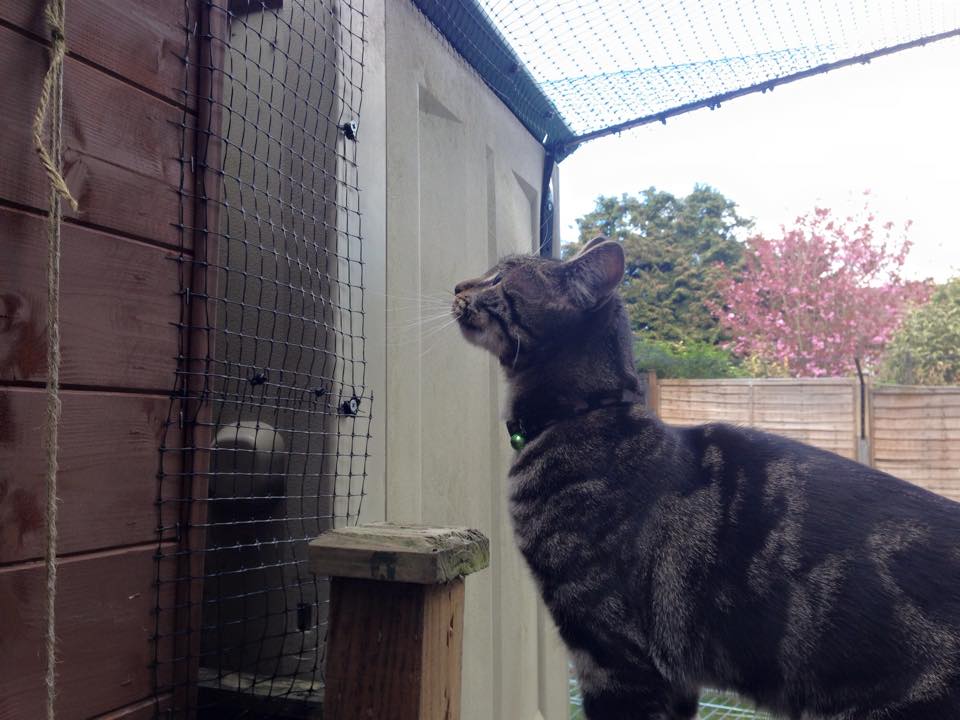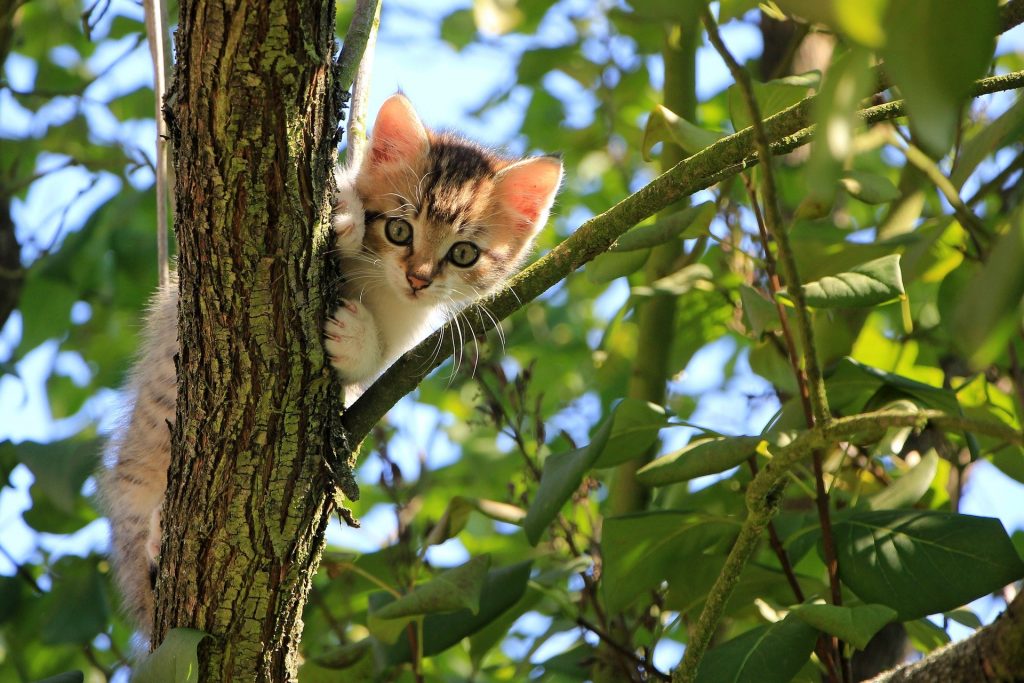Cat proofing your garden is becoming more and more popular, but is it worth it? Read my experience on having cat proof fencing and if I recommend it.
Why do people cat proof their gardens?
There are lots of reasons people choose to cat-proof their garden, and I would like to say now it’s your choice what you choose to do. As long as you have read all the facts and have a good understanding, don’t let anyone guilt you either way. It’s your cat and you must decide what is best for you, your family and your cat.
Some cat owners worry their cat may get lost, stolen, hurt or worse if let out. Expensive pedigree cats can be targets of theft and many owners prefer to keep them indoors, especially if they are used for breeding. You may have a cat with a disability, perhaps they are deaf or blind and you would worry they would get lost or trapped somewhere with limited senses. Cats love being outdoors, so cat proofing your garden could be a good option if you have these worries.
What options do I have?
The first option is to let your cat out to roam like thousands of cat owners do up and down the country. Ideally, this should only be done if you live away from the main road and perhaps the easiest way to allow your cat free access is with a catflap.
Like most things in life, there are pros and cons to this, so weigh it up before deciding. If you are against letting your cat outside on their own, other controlled methods are;
Harness training
A harness and lead mean that you can lead walk your cat without the fear of them running off. There are lots of styles out there, choose a well-fitting one with padding for comfort and a lightweight lead.

Pros of cat harnesses
- Relatively cheap to buy.
- Allows your cat safe time outside.
- Some cats love it – it gives them a chance to bond with their owner and go in the fresh air.
Cons of cat harnesses
- Not all cats will accept them – usually its best to lead train kittens but restraining a cat’s movements with a harness can make them feel a loss of control.
- Some cats can wriggle out of them.
- You can’t walk them like a dog – you have to follow your cat so you need a garden or park to walk them in.
- If they get scared, they can freak out and even use their claws on you to try to get away.
- If you walk them somewhere away from home like a park and they escaped, they wouldn’t know how to get home.
- Once they get the taste of outdoors they may wail at the back door and door dart.
Catios
Catios (cat-patios) are enclosures that can either be attached to your house or freestanding in your garden which allow your cat outside whilst confining them to a secure place. Catios can be as big as you like, some are built around an outside window whilst others take up more of the garden.

Pros of Catios
- They allow your cat outside in the fresh air in a controlled way.
- They allow your cats lots of enrichment – they can watch the birds without being able to catch them.
- You can give them lots of toys and enrichment.
Cons of Catios
- They can take up a lot of space, which can be a bad thing if you have a small garden or use the garden for other things other than cat stuff.
- If they attach to a backdoor, you will need to have a door in the catio to enter the garden. It could be a good investment to get a double door to prevent escapees.
- If the catio is attached to a window, your cat may get used to going out a window and could try to get out other windows in the house.
- Your cat cant run around if the catio is small.
- Purpose-built ones can be expensive.
- You will need a waterproof roof if you want your cat to use it all year round.
Fence rollers
Fence rollers are rollers that are secured to the top of your fence. The idea being when your cat tries the climb over the fence, the rollers roll and prevent them from being able to launch themselves up, keeping them in your garden.

Pros to fence rollers
- You can make them yourself if you are good at DIY using a PVC pipe.
- Good for small gardens.
- Depending on the type, they are non-offensive to look at.
Cons to fence rollers
- You need a solid fence to attach it to.
- They cannot be attached to hedges.
- They are hard to install if your garden is an irregular shape.
- If you move home, they are difficult to take with you.
- If you buy them from a company, they are expensive.
Cat proof fencing
When I looked into getting cat-proof fencing I was fostering cats for the rescue I was working with. I love being outdoors and usually leave my back door open, allowing my dog’s free access to the garden. I was also in and out all day seeing to the rabbits.
I wanted cat proof fencing because the cats I fostered lived free in my house and I didn’t want them running away if they weren’t sure where they were meant to return to. Cat proof fencing allowed me to leave the door open and not worry where the cats where. It also increased the space I could offer the cats I had, giving them more room to have their own territories.
How does cat-proof fencing work?
There are several different types of cat-proof fencing. Most types have brackets that attach to your fence post and are angled, physically preventing your cat from jumping out (allegedly).
There are other types of brackets where the arms at the top of the bracket bend downwards should your cat jump up, again, stopping your cat from escaping. You then need to put mesh around the perimeter of the garden to join the brackets together and create a barrier.

How expensive is cat-proof fencing?
Cat fencing is (very, very, very) expensive. There are companies who will fit it for you, or you can buy a kit and install it yourself. For basically metal brackets and mesh, a set up for a small garden will be around £2k.
How does it look?
No matter how you have it, personally, I don’t think it looks very nice (it kinda resembles prison fencing). All the brackets I have come across are black and the netting is black too. As the brackets lean into the garden, they make your garden feel smaller. I did have neighbours complain about it too because of the look it gave and if your fences are shared with your neighbours, it’s worth talking to them before installing the fencing.

Does it work?
Ok, so I am going to be brutally honest here… it didn’t contain all of my cats. The old, slow cats couldn’t get out, however, I had two kittens at the time and they managed to escape from it within 20 minutes the first time they went out. I contacted the company who said I can’t have anything against my fences as the cats use it as a springboard to get out (this wasn’t mentioned in the consult or when the fences were installed by the company).
As I said, I was fostering animals at the time and have several rabbit hutches and rabbit runs in the garden, as well as a shed, bins and garden furniture. I had the rabbit hutches at one end of the garden and this section was gated off to keep the dogs out. I was told to move everything to the middle of the garden to stop the cats getting out. This wasn’t practical for me at all – my garden at the time was small and I didn’t want everything bunched up in the middle. However as the cats were using the rabbit gate to jump out, this wouldn’t have worked as the gate was a fixed structure in the garden.
Of course, this was just my experience and I’m sure cat proof fencing does work for some people. It was just a large outlay which turned out not to suit our needs entirely.

Maintence
In the autumn, leaves fall and collect in the netting and in the winter, snow collects in it. This weighs heavily on the netting and makes it bow, to be honest, if left the cats could probably use it to get out and I think the netting would snap with the weight. You need a long-handled broom and push the netting to remove the leaves or snow. If your garden is attached to your neighbours, they may not be too happy with you knocking leaves or snow into their garden, so bear that in mind!
Our brackets also went a bit rusty, which I guess is to be expected but it does mean the brackets would have needed replacing at some point. The system does mean you can take it down so it can go with you if you were to move house. You would probably need to buy new netting though as we had to cut ours to get it down.
Is it worth the money?
Although cat proof fencing works for some, it won’t work for everyone. In my experience, it wasn’t worth the money at all. My cats are moggies and could get out, so I couldn’t honestly recommend this product. Its expensive, ugly and quite frankly, didn’t do the job for me.
If you want to let your cats experience the outdoors in a controlled way, I would suggest going for a catio. A friend of mine had her husband make one for her cats using timber and chicken wire. It’s attached to their lounge window and her cats love being outside and watching the birds. She also gives them new toys all the time to keep them happy and active.
Many thanks to Camilla Wellstead for allowing me to use her photos.


